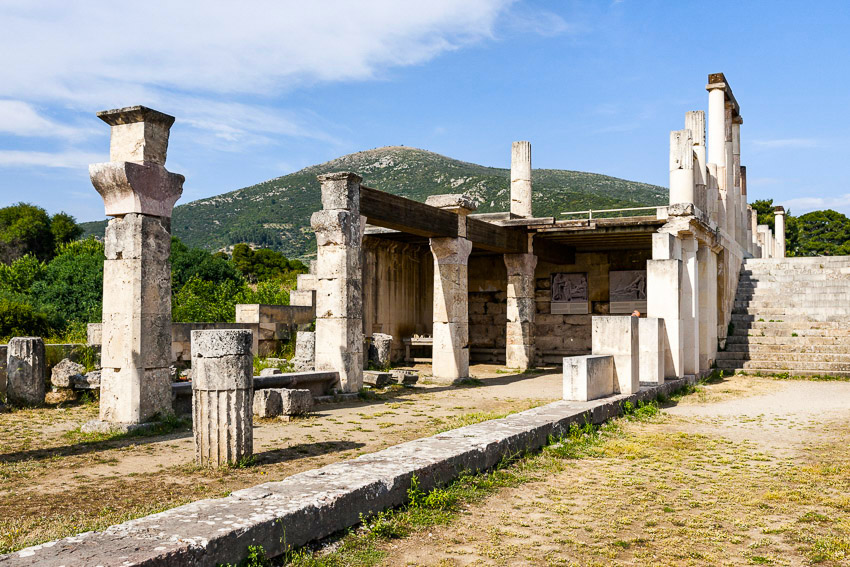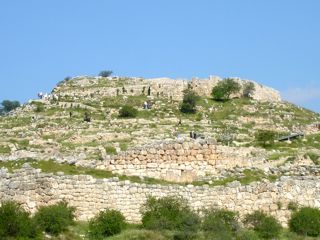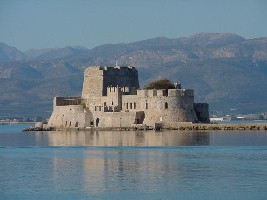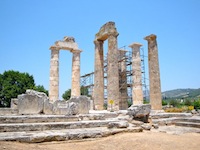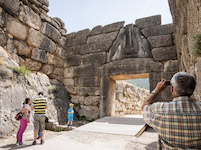
Epidauros
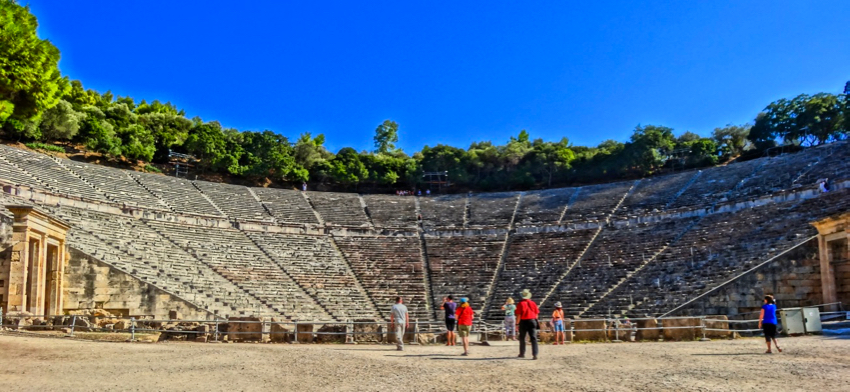
The Sanctuary of Asklepios in Epidauros & its Ancient Theatre |
|||
|
The "Asklepieion" or Sanctuary of Asklepios in Epidauros is mostly known for its 2,350 year-old theatre, famous for its spectacular acoustics, an impressive seating capacity of 12,000, and the performances of classical theatre plays by Aischylos, Sophokles, Euripides, and Aristophanes, dating from the 5th and early 4th century BCE but brought back to life every Summer since 1955 during the Athens-Epidauros music, dance, and theatre festival. Yet it was in 1938, almost twenty years prior to the launch of the Festival, that a production of Sophokles’ Elektra became the first modern performance to be held at the Ancient Theatre of Epidauros. This surely makes it into one of the oldest buildings in the world that is still in use today and continues to serve remarkably well the very purpose it was built for by its architect, Polykleitos the Younger, around 340 BCE. As with most Ancient Greek theatres, long before any stone seats were put in place, people would simply sit down on the natural slope of the hill in a semicircle to enjoy the performances. When Polykleitos' work was finished, the 80-meter wide "koilon" or cavity in the slope on which the limestone seats were placed, was divided into 12 segments, counted 34 rows or tiers, and could accommodate up to 6,000 people. Because the fame of the sanctuary and its medical expertise drew more and more visitors during the following centuries, even well into Roman Times, the capacity of the theatre was effectively doubled in the 2nd century CE by adding 21 tiers above the 34 original ones, divided into 22 segments, making the theatre into one of the largest of the Ancient World. |
|||
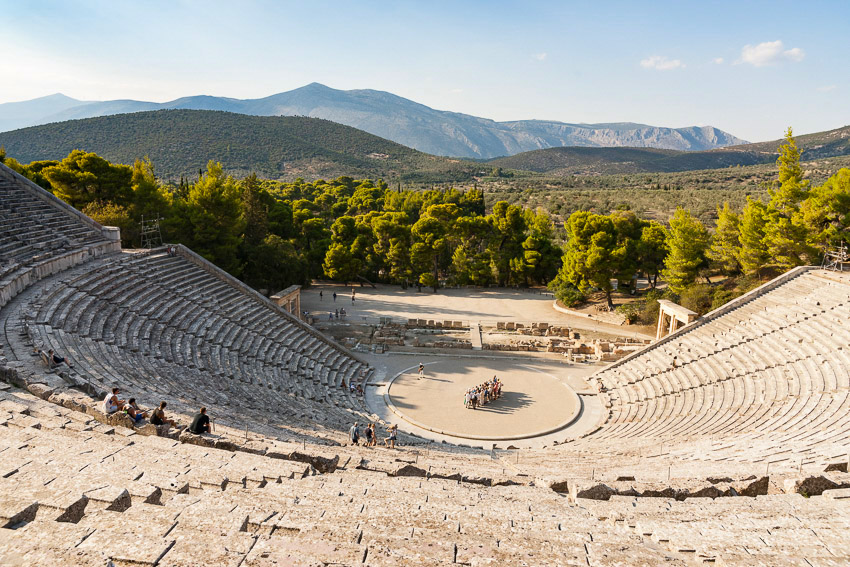 |
|||
|
Visitors today are often misled in their perception of ancient theatre performances by the fact that certain aspiring candidates of a musical or acting career, feel an irresistible urge to demonstrate the famous acoustics of the theatre, go right to the centre of what is effectively the "orchestra" but not the real stage, blasphemously stand on top of the circular slab of marble which is in fact the altar of Dionysos (the deity to whom ancient theatre plays were dedicated), start to drop coins on it, clap their hands, shout out loud asking if they can be heard and understood well by the spectators on the 55th and very last row, pretend to be a stand-in for Cecilia Bartoli, or mistake Euripides for Shakespeare and ask themselves in a more or less dramatical way that famous existential question. As a big fan of (ancient) theatre plays and a regular visitor to the site, I cannot expect everyone to know that the Greek name for the seating sections is "kerkides", that the "klimakes" (climax...) are the ascending stairways, and that the "diazomata" are the horizontal passageways running all around the "koilon" (the cavity of the theatre). But it might be worth remembering that in Antiquity all acting was done on the "skènè" (or scene), at first a rather simple wooden platform with some architectural elements that could be moved or replaced according to the needs of the play, but later on grew into a real stone building, located behind the circular "orchestra". Today only a few stones of that "skènè" are left standing and are carefully protected by the archaeologists because of their historical importance. |
|||
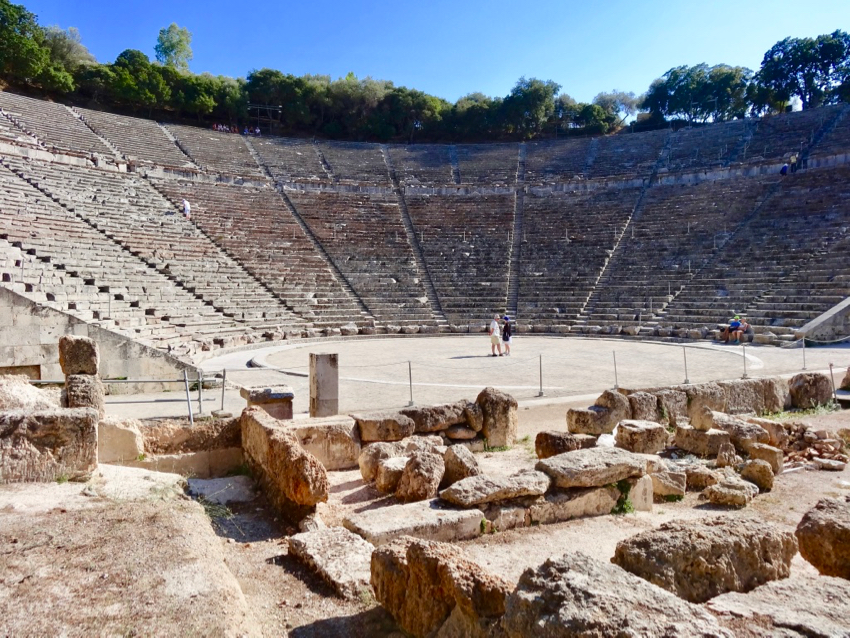 |
|||
|
On the circle in the middle of the theatre, the "orchestra", only the choir (often a group of young girls) performed during the theatre plays or rather in between the different acts, dancing hand in hand round and round the altar and singing or reciting texts that summarised and commented upon what had just happened on stage in the previous act, and sparked curiosity about what would happen in the next one. Perhaps they were accompanied by live music, but whilst we do have the complete texts of a number of ancient plays (against an overwhelming majority of plays of which we only know the title and nothing more!) and even know a few names of famous actors, the way the plays were directed and performed, is still very much an unknown and uncharted territory. The interludes performed by the choir on the "orchestra" allowed the actors (which usually were only three and always male!) to change costumes and masks, and gave the technicians enough time to re-decorate the scene with a new painted background and other stage requisites before the curtains re-opened. The importance of the creation, performance, and popularity of theatre plays in Ancient Greece can hardly be underestimated, especially because they are considered to be one of the pillars on which the Athenian democracy was built in the 5th century BCE. The word "theatre" itself is derived from the root of the verb that signifies "observing", "watching, "looking at". This is no coincidence. To create a (literally and figuratively) "moving" visual performance out of what until then had existed only as words and verses sung by bards or recited by story-tellers, as still images on expensive vases decorated with mythological scenes in the houses of the rich, or as books in the same people's libraries, made the stories come alive again - for everyone. In the beginning the theatre plays were meant as a kind of sacred re-enactments of ancient stories that were performed during annual festivals. But at the end of the 5th century BCE they had been morphed by the classical authors (Aischylos, Sophokles, Euripides, and Aristophanes) into powerful tools for critical thinking because they were treating the ancient subject themes with kings and queens, heroes and heroines, good and evil, love and betrayal, in such a way that the public was forced to ask itself questions about the moral, social, individual, and political dilemmas that were presented on stage before their eyes, and looked just as contemporary then as now. |
|||
|
Let us take one of these ancient "dramas" (a word which was originally very neutral in its meaning of "something that is performed or carried out") and see how it can still be of great value and use today: Sophokles' Antigone. The main character of the play, Antigone, is the niece of Kreon, the new ruler of Thebes. Her two brothers, Eteokles and Polyneikes, were both leading opposite sides in Thebes' civil war and died fighting each other for the throne. As Kreon was favouring Eteokles during the civil war, he decrees to give him all official honours and a state burial whilst condemning Polyneikes' body to be left without any funeral rites on the battlefield, unburied, and prey for vultures and other animals. Antigone, however, feels bound by the sacred, moral duty to bury her brother Polyneikes, in total defiance of Kreon's edict. This creates the dilemma which is at the core of the play: What law is more just and needs to be obeyed unconditionally: the law of men or the law of morality, inspired by the gods? Antigone, still a young girl, basically an adolescent, decides to act against the will and rule of the most powerful man in Thebes by burying her brother Polyneikes' body and give him the necessary funeral rites. She succeeds by symbolically covering the body with a thin layer of earth and drawing a line around it, but is caught in the act as Kreon had ordered sentries to patrol the area. When Kreon questions Antigone, she doesn't deny and argues with him about the morality of his edict against the morality of her actions. As Kreon fears his authority is coming under threat, he applies the new law and orders his niece to be temporarily imprisoned. To make matters even more complicated, Antigone is engaged to Haimon, the son of Kreon, who tries to persuade his father to spare and release Antigone, but totally unsuccessfully so, as father and son start to argue and insult each other. Haimon leaves the palace, vowing never to come back. Kreon furiously decides to take Antigone from her prison cell and bury her alive in a cave, never to see the daylight again. Before Kreon can gather his senses and realise that he has gone too far in not allowing Polyneikes to be buried and condemning Antigone to die a horrible death, Antigone hangs herself, Haimon stabs himself to death, and Eurydike, Kreon's wife, kills herself in the palace. Kreon has been punished very harshly for his "hubris", for his stubbornness of putting his law above the one of moral justice and denying himself the courage and force of human kindness, love, and compassion, so well incarnated by Antigone. On both pediments of the temple of Apollon in Delphi, where in full trance the priestess of the Pythian oracle gave seemingly senseless answers to the questions that were put before her, were written four simple Ancient Greek words that made and still make total sense: "gnothi seauton" - know thyself - and "mèden ágan" - nothing extreme. Be aware of your own capabilities but also of your own limitations, so you can make the right decisions in life. And never exaggerate in anything that you do or think, but always try to keep yourself and things around you in balance and harmony. When Sophokles' Antigone premiered in 441 BCE in Athens, in the cradle of the newborn political system called Democracy, its characters had died a long time ago, its dramatic storyline was already very ancient and legendary, but its message was still very much alive, and was loud and clear: Are laws made by men always unconditionally just and morally right? How far are we willing to go in applying these laws when they can have consequences that we were unable or unwilling to see? How do we act and how do we judge when these laws come into conflict with what obviously is equally just and right: individual moral behaviour, kindness, love, and human compassion? And if, some 2,500 years later, we are able and willing to see through the costumes and masks, and make abstraction of the storyline and its tragic events, Antigone still confronts us and asks us the same old questions. Only a few weeks ago, early August of 2017, a French citizen was punished by law for helping refugees cross the border from Italy into France. By law it is forbidden to help foreigners who want to enter or reside in France illegally. The French citizen, however, pointed out to the court the existence of a much older law of the French Republic that specifies it is everyone's moral and legal duty to help people who are in danger. Although he risked imprisonment, he was only sentenced to pay a fine, on condition he would not repeat his "illegal" actions - a condition he bluntly refused to accept. As a side-note, it should be mentioned that, although so many Greek tragedies seem to contain scenes of murder and suicide, not a single act of violence or bloodshed was ever performed on stage. When a murder or suicide was part of the story, the act itself was not shown to the public, as this would have been considered sacrilege (remember, a theatre performance was considered to be a religious or sacred activity). Instead, only the results of the violent act were shown, meaning that behind the curtains and thus invisible to the public, an actor would cry out loud in pain, and that, once the curtains opened again, he would lie down and play "dead" with a dagger or sword next to him, or a rope around his neck. Roman theatre plays were often far less "civilised" and "sensitive" than the Greek ones, and sometimes had slave girls raped or criminals killed "in real life" on the stage whenever the script asked for such violent acts to be performed. One final remark about the tragedies written by Aischylos, Sophokles, Euripides, and the comedies by Aristophanes: A remarkable number of them have a woman or young girl as their main character. Antigone is but one famous example of a heroine who puts powerful men to shame, Iphigeneia (daughter of Agamemnon and Klytaimnestra, and on her own more courageous than the whole of the Greek army) is another one. Alkestis also comes to mind, who willingly sacrifices herself so her husband can become immortal. And then there's the intriguing Medea, as shown to us by Euripides, who wrote the most psychologically compelling and "modern" dramas. According to the legend and the theatre play, Medea takes revenge upon her husband Jason when he leaves her for another woman, by murdering her own children by him. At first sight, such violent and cruel act by a mother might seem a totally unreal or exaggerated dramatic invention by the author, but unfortunately, modern psychology teaches us that even nowadays there are women who commit such a horrible and almost incomprehensible crime when left behind by their partner. |
|||
The Sanctuary of Asklepios |
|||
|
Describing the magnificent theatre in Epidauros and the role of theatre plays in the awakening of critical thinking as an essential element for a well-functioning democracy, could mislead you into believing that all the other buildings, the ruins of which lie to the South-West of the theatre, behind the modest but charming old museum, were secondary to the theatre and built in function of it. Or that those are the very badly preserved ruins of the "city" of Epidauros. This is not the case at all. Sometimes tourists ask a very relevant question: Why did they build such an enormous theatre in the middle of nowhere? |
|||
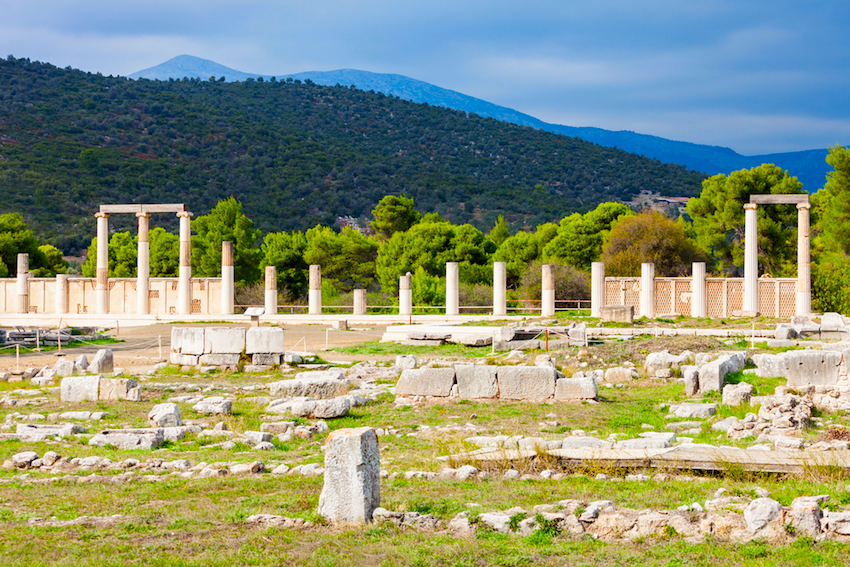 |
|||
|
The answer is: They didn't. This is or was not the middle of nowhere. This once was the most important medical centre of the classical world. The theatre, how magnificent and important it might have been and still is, was only built as part of the sanctuary of Asklepios. This sanctuary was not a city, it was a healing centre, with hospital and surgery rooms, hot and cold baths, a restaurant with special diets for patients, a hostel for patients and their family, a psychotherapeutic centre, several temples, fountains, gardens, a stadium, and a theatre, obviously. This was the first and largest medical centre of Classical Antiquity and it gave birth to several others on the mainland and islands of Greece. It functioned almost uninterruptedly for more than a millennium, from around the 6th century BCE to the middle of the 6th century CE, when it had to be abandoned definitively after two destructive earthquakes. This natural disaster, several destructive invasions by the Visigoths during the 3rd and 4th century CE, and the edict of the Byzantine Emperor Theodosios II in 426 CE banning all non-christian religious practices, explain why travellers of the 18th and 19th century saw barely more than a large number of stones lying around randomly on a flat terrain, with only the theatre more or less intact yet covered by bushes and trees. But let us go back to when, how, and why this sanctuary came into existence. |
|||
|
It carries the name of Asklepios, son of Apollon and Koronis, and the legend of how he was born and raised is once again a very Greek story. Koronis, a mortal princess, was Apollon's lover and became pregnant by him. But when he was away, she fell in love with a mortal man. A white raven which Apollo had left to guard her, informed him of her betrayal. Apollon, angry with the bird because it had not pecked out his rival's eyes as soon as he approached Koronis, cursed the raven so furiously that its feathers got scorched - which is why all ravens are black! Apollon then asked his sister, Artemis, to punish and kill Koronis as he could not bring himself to do that. Only when he saw his lover's body burning on the funeral pyre, he regained his senses and sent Hermes down to cut the unborn child out of her womb. Hermes then placed the baby on top of Mount Titthion, which is the mountain or hill just to the North-West of where later on the sanctuary would be built. On Mount Titthion Asklepios was found by a shepherd's dog and the shepherd saved the baby by feeding it goats' milk. When Asklepios became old enough to be educated, Apollon sent the centaur Kheiron to be his teacher of medicine and healing. One of the many medical secrets that was revealed to him, was the use of snake venom in pharmacy. These are the two reasons why Asklepios is usually portrayed in the company of a shepherd's dog lying at his feet, and a snake coiling up his wooden staff. The legend doesn't say anything about the origins of the sanctuary or healing centre. For this we must turn to what archaeology has discovered on and near the site, which is situated in a small valley that used to be very lush and full of trees thanks to a mountain stream coming out of the slopes of Mount Kynortion. Some 4,000 years ago already, this place was considered to be sacred, most probably because of the presence of fresh water containing healthy minerals and a large number of various medicinal herbs that could be found in the grove. On a low hill to the South of Mount Kynortion a small prehistoric settlement was found, which was never built on in later periods. A few centuries later, at the beginning of the Late Bronze Age, an open-air altar was constructed on which animal sacrifices were made. Votive offerings such as bronze double axes, bronze swords, and clay animal figurines were deposited in the ashes. This first sanctuary was dedicated to a deity called Maleatas, whose healing powers were later on identified with those of Apollon. |
|||
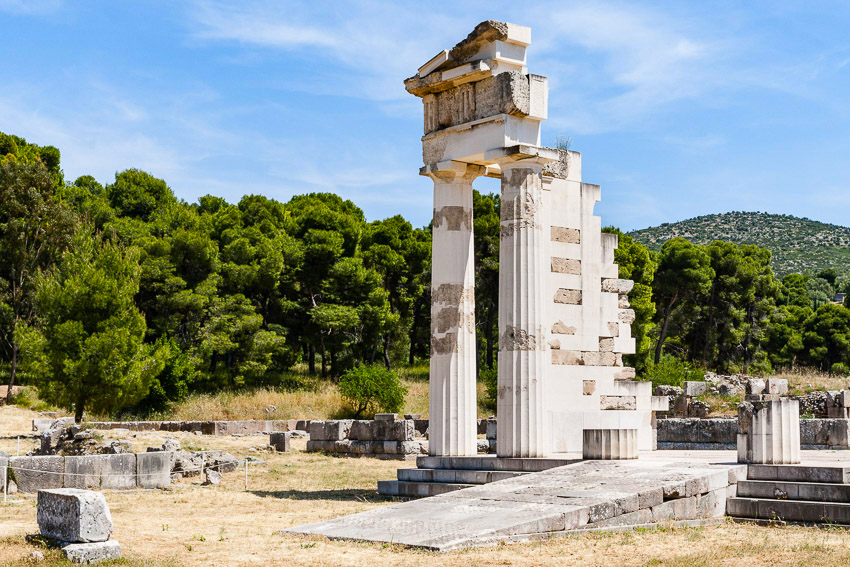 |
|||
|
From the 5th century BCE the worship of Asklepios as a deity who was concerned about the well-being of humans and possessed great powers of healing and prophecy, replaced that of his father, Apollon Maleatas. Very soon the sacred site was visited from all over Greece by those seeking medical therapy and healing of their illnesses by either divine intervention or medicines administered by the resident priests. The original sanctuary of Apollon Maleatas up the hill, containing a temple of Apollon, a shrine and garden for the Muses, living quarters for the priests and staff, a stoa or gallery, and some later Roman architectural additions, continued to function for centuries. However, the wealth that was gained from dedications from the worshippers, was now mainly used to build a new and very impressive complex of buildings in the valley to the West. This is the site that can be visited currently, next to the theatre and the small museum, and it is not to be confused with the ancient city of Epidauros, which lies some 10km to the East of the Sanctuary, in present-day Archea Epidauros. |
|||
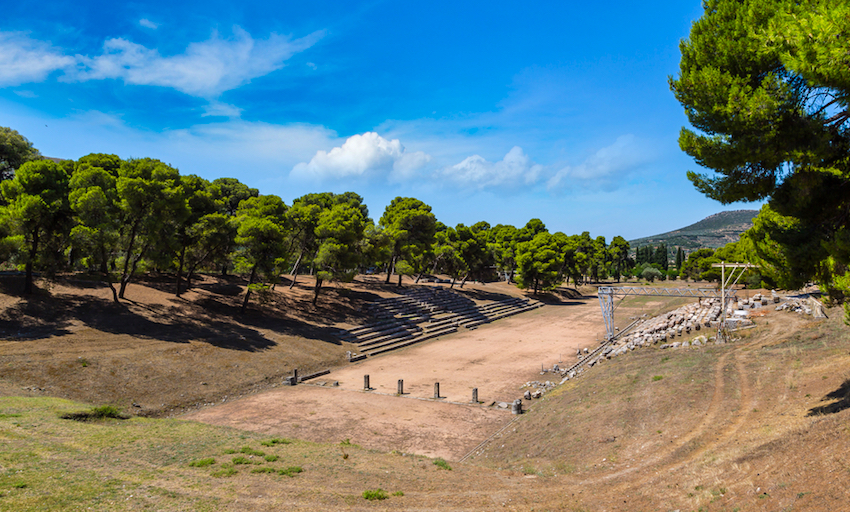 |
|||
|
It is estimated that only about one third of the sanctuary of Asklepios has been excavated since the start of archaeological activities in 1881. Of course, restoration and conservation work still continues, and there are plans to completely re-develop the site, build a new museum and even a small centre for national and international medical conferences. One of the buildings that attracts the attention of most visitors, is the so-called Tholos or Thymele, a round temple designed and constructed by Polykleitos the Younger, whom we already know as the architect of the theatre. Presently, the Thymele is being reconstructed partially, using sparkling white marble blocks from the island of Paros which are being sculpted with the use of a special machine on site. It is most interesting to see the rectangular blocks being cut into round cylinders, to which then fluting is applied, which is the cutting of grooves into the surface of the marble cylinders, effectively making them into the different parts of a column. The Thymele has a mysterious circular underground labyrinth, whose precise function remains a mystery until this very day. What we do know from several authors who visited the site, is how it was admired and considered to be one of the most beautiful temples of Classical Antiquity. Its elegant outer colonnade will now be resurrected - at least partially - and segments of its circular walls and inner colonnade as well. However, its splendid floor with chequered white and black marble tiles, its refined architectural and sculptural details around the roof, and its intriguing paintings which once decorated its ceiling, are sadly lost forever. A number of drawings that can be seen in the museum and an image search on Google for the words "Tholos in Epidauros" help us to imagine how beautiful it must have been. |
|||
|
|
|||
|
Close to the Thymele we find another unusual building: the Abaton or Enkoimeterion. Patients suffering from all kinds of diseases and traumas were put to sleep here, among which a high number of pregnant women or women who had problems giving birth. These patients were probably given a potion or other substance that would make them sleep and dream or perhaps hallucinate, so their dreams and visions could be analysed and interpreted the next day. Some 70 "iamata" or short descriptions of cures have been found on the site, engraved on stelai. The medical problems and illnesses that were treated in the Asklepieion range from headaches over broken limbs to cancer. Countless surgeries were performed and some of the bronze surgical instruments that were used there and then, are on display in the museum. There is no doubt about the expertise of the doctor-priests at the Asklepieion who had studied anatomy and anaesthesia, pharmacy and hygiene, diet, and the importance of sports (the stadium...), relaxing baths, and entertainment for the mind (the theatre...). In short, the sanctuary had all the facilities of a modern-day sanatorium, with hot and cold baths, stoas, gardens, a restaurant where appropriate meals where served to the patients, and even a hostel. |
|||
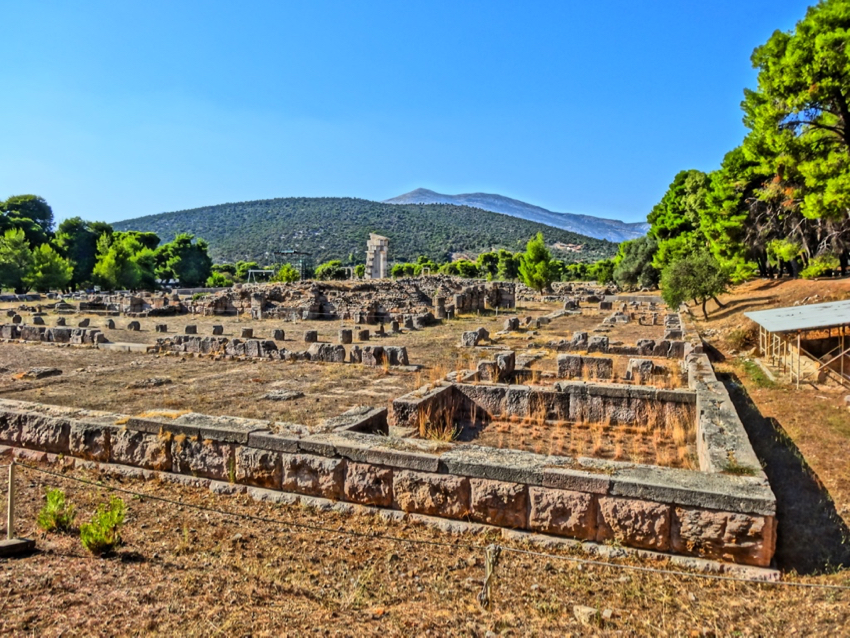 |
|||
|
Of the temples of Asklepios, Aphrodite, Artemis, and Themis, sadly only ruined fragments survive, whilst their cult statues seem to have disappeared entirely. The main buildings of the sanctuary were connected by paved roads, one of which is still visible in front of the remains of the stoa to the NE of the Abaton and Temple of Asklepios. The presence of many fountains and wells, and the remains of a complex network of pipes and gutters show how important an uninterrupted and sufficient supply of fresh water was for the site. Two enormous underground cisterns can still be seen, one situated near the Roman Baths to the North of the Abaton, the other outside the sanctuary itself, some 800m to the East, next to an old path leading to Mount Kynortion. Most visitors don't venture into the Northern part of the archaeological site and therefore miss the ruins of the Propylaia, the ancient entrance to the sanctuary, where everyone who arrived at the sacred site, was ritually cleaned and could refresh himself using the water of the big well a few meters away. The well and the stone basins used for this purpose can still be seen left and right of the Propylaia. Those who came to be healed, had to pay a fee, which was proportional to their income and financial status. Those with modest financial means were allowed to pay by bringing some food like eggs or a chicken, others were wealthy enough to offer statues, fountains, or other works of art to the sanctuary in return for a successful treatment of their illnesses. Finally, not far to the East of the Propylaia, behind a number of beautiful pine trees one can find the remains of one of the earliest Christian churches in Greece, in the shape of a Roman basilica. |
|||
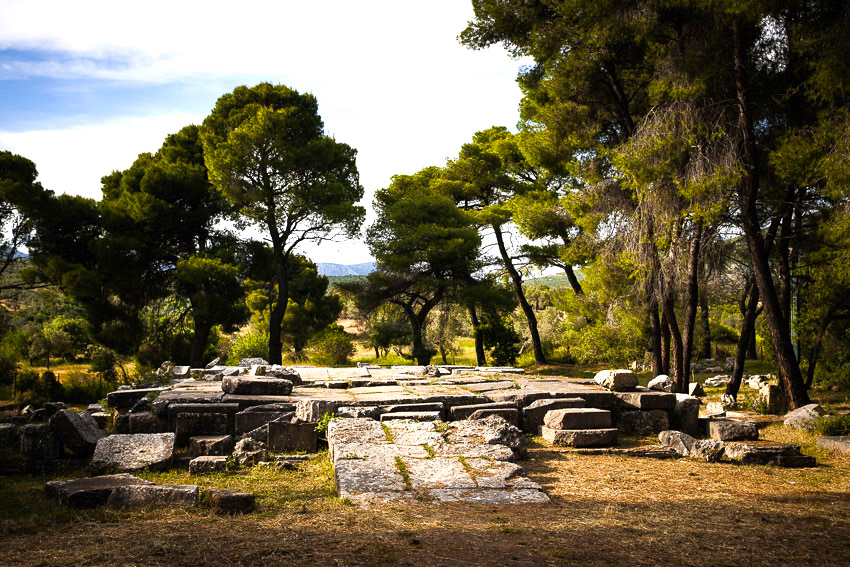 |
|||
|
Ending our visit of the sanctuary at the Propylaia is like making a circle full, as the ancient road that was used by countless pilgrims, patients, and those who accompanied them, all coming from and going back to the city of Epidauros some 10km to the NE, enters the sanctuary right here. Walking back towards the museum and the modern entrance of the site and pondering over the ruined remains of the first medical centre in the Western World - one which gave birth to dozens of similar sanctuaries and healing centres of Asklepios all over the Mediterranean - we can only guess at the amount of medical knowledge that was lost when the buildings and almost all their contents were destroyed. We have no documents left from the medical library of the sanctuary, the exact place of which is still unknown. Where was the pharmacy, where pills, potions, and ointments were manufactured? Were there any laboratories, such as those that existed at the university of Alexandria in Egypt? The ruins of the buildings here stand symbol for far more than the destruction of art and architecture. When the Roman general Sulla invaded the Peloponnese in 86 BCE, he looted the sanctuary. A few years later it fell prey to invading pirates from Cilicia. The medical centre suffered from all this but survived. During the second half of the 2nd century CE several old buildings were restored and new ones were added to the site by the Roman consul Antoninus as part of a major restoration and building project. Alas, in the following two centuries the Visigoths razed the sanctuary twice. Still it wasn't abandoned but again restored and refurbished. However, it received a serious blow by the official ban on non-christian religious practices that was issued in 426 CE by the Byzantine Emperor Theodosios II. Although the worship of Asklepios and the medical care provided in the sanctuary were continued, it must have been on a much smaller scale. Sadly and finally, the sanctuary of Asklepios in Epidauros was completely abandoned after two very destructive earthquakes in 522 and 551 CE. It took Europe almost another millennium to rediscover medicine as a science in the Renaissance. |
|||
|
Angelos Asklepiades photographs and writes about his passion: archaeological sites and their history, legends, and stories. Based in the heartland of the Mycenaean civilisation, the Argolid, he explores mythical hills and magical valleys in search of ruins and roads that were seen and described by travellers of the 18th and 19th century. A master's degree in Classical Philology and Greek Archaeology helps him to share to a general public what colleagues in history, philology, and archaeology research, excavate, and publish. You can contact him at garden.of.the.muses@gmail.com |
|||
Helpful Epidauros Tourist Information |
|||
|
Epidauros is about a 3 hour drive from Athens and about 40 minutes from the town of Nafplio. There are restaurants and hotels nearby in the towns Nea Epidavros and Palia Epidavros which are both on the sea and you can also stay in Nafplio. Many people include Epidauros when they do a One Day Tour of the Argolis with George the Famous Taxi Driver or as part of a longer trip around the Peloponnesos. Fantasy Travel also offers the Mycenae - Epidaurus 1 Day Tour and their Mycenae - Epidaurus 2 Day Tour and it is also included in their 4 Day Classical Tour, their 5 Day Classical Tour and their 7 Day Grand Tour of Greece. If you plan to go by bus they leave from the Kifissos Bus Station and continue on to Argos and Nafplio. See Schedules. You can also rent a car through Swift Rent-a-Car and Fantasy Rent-a-Car and go on your own. For hotels in and around Nafplio see Booking.com's Nafplio Hotel Search. You can find more hotels on Matt's Hotels of Greece Argolis Page For tours of Nafplion, Myceneae, Epidavros, Nemea, Corinth, Tiryns, Argos and other places in the Argolis and the Peloponnesos with a licensed guide see Elias Papadopoulos: Tour Guide in NafplionA special thanks to Fantasy Travel for a few of the photos on this page which they actually got through DepositPhotos.com and to Mark Cartwright for the rest. Be sure to visit these nearby places as well |
|||
Help Support Matt's Greece Guides
Do you enjoy using my site? Have you found it entertaining as well as useful? If so please show your appreciation by booking hotels through the travel agencies and the links found on my Hotels of Greece site. The small commission I make on the bookings enable me to keep working and in most cases you won't find them any cheaper by searching elsewhere. You can find
hotels in Greece by location, price, whether or not it has a swimming pool, and see photos and reviews by using this link to booking.com which also contributes to my website when you book. If you are appreciative of all the free information you get on my websites you can also send
a donation through Paypal or Venmo
Join Matt Barrett's Greece Travel Guides Group on Facebook for comments, photos and other fun stuff. If you enjoy this website please share it with your friends on Facebook and other social media.
